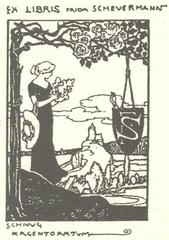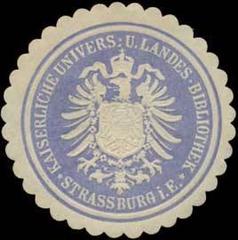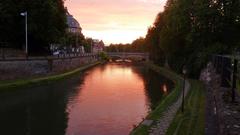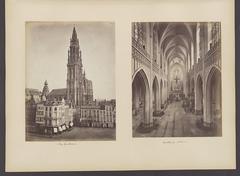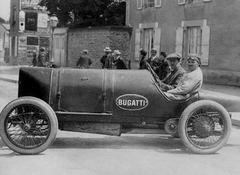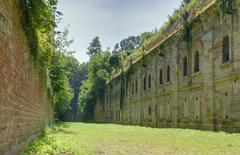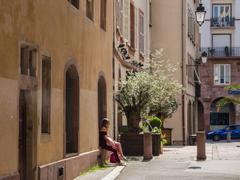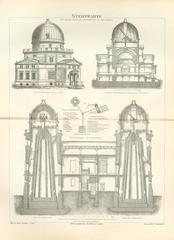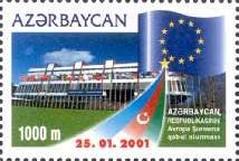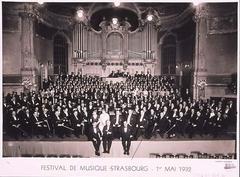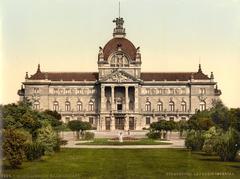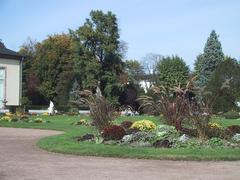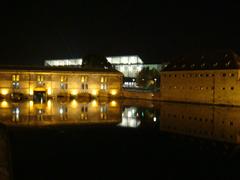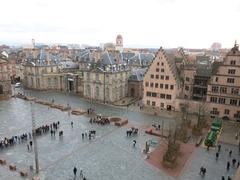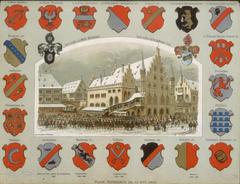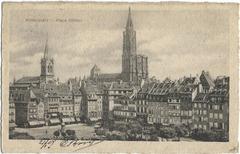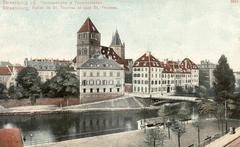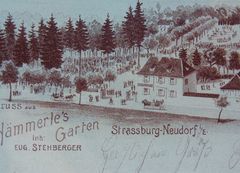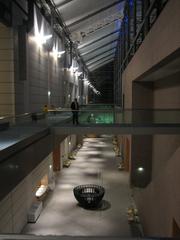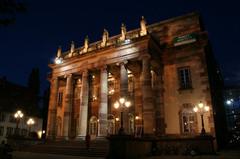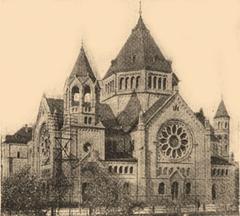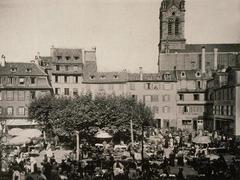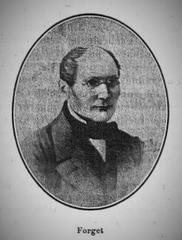Gutenberg Stele Strasbourg: Visiting Hours, Tickets, and Historical Sites Guide
Date: 03/07/2025
Introduction
Strasbourg’s Gutenberg Stele and the grand statue of Johannes Gutenberg stand as enduring tributes to the inventor of the movable-type printing press—a figure whose innovations transformed the course of world history. Situated within the UNESCO-listed Grande Île, these monuments not only commemorate Gutenberg’s pioneering achievements during his Strasbourg years (1434–1444) but also reflect the city’s deep-rooted legacy as a center of civic, intellectual, and artistic life. Whether you are a history enthusiast, a cultural traveler, or a curious explorer, this guide offers detailed information on visiting hours, accessibility, highlights of the monuments, nearby attractions, and practical tips, ensuring a memorable and insightful experience in Strasbourg.
For the latest updates and in-depth information, consult official resources such as the Strasbourg Tourism Site, Archi-Wiki, and Wikipedia.
Table of Contents
- Gutenberg’s Strasbourg Years and the Birth of the Printing Revolution
- Place Gutenberg: Civic Legacy and Urban Evolution
- Gutenberg Monument: Artistic Vision and Symbolism
- Visiting the Gutenberg Monument: Hours, Tickets, and Accessibility
- Travel Tips and Getting There
- Nearby Attractions in Strasbourg
- Frequently Asked Questions (FAQ)
- Gutenberg Stele on Île Gutenberg: History, Art, and Practical Information
- Comparative Artistic Context
- Preservation and Community Engagement
- Additional Resources & References
- Conclusion
Gutenberg’s Strasbourg Years and the Birth of the Printing Revolution
Johannes Gutenberg’s time in Strasbourg (1434–1444) marked a pivotal chapter in the development of the movable-type printing press. During this formative decade, Gutenberg collaborated with local craftsmen and financiers, refining techniques in typecasting, ink formulation, and press mechanics. While his famed 42-line Bible was later printed in Mainz, Strasbourg proudly claims its share of his legacy, asserting that key breakthroughs in printing technology occurred within its city walls (strassburg.eu; Wikipedia). This era not only set the stage for the mass production of books but also established Strasbourg as a hub of commercial and intellectual exchange within the Holy Roman Empire.
Place Gutenberg: Civic Legacy and Urban Evolution
Place Gutenberg, formerly Place Saint-Martin, is steeped in Strasbourg’s civic history. From the Middle Ages through the 18th century, it functioned as the city’s administrative and judicial center, featuring essential structures such as the Pfalz (Town Hall), the Chancellerie, and the city mint (strasbourg.eu). Over centuries, the square’s character evolved—from a religious precinct to a bustling civic space and, ultimately, to a site of memory and commemoration. The Renaissance-style Neubau, completed in 1585, is a notable survivor from this era and now anchors the square’s western edge.
In 1840, on the 400th anniversary of the printing press, the square was renamed Place Gutenberg. The inauguration of the Gutenberg statue that year solidified the site’s new identity as a focal point of Strasbourg’s intellectual and cultural heritage.
Gutenberg Monument: Artistic Vision and Symbolism
The monumental statue of Johannes Gutenberg, created by Pierre-Jean David d’Angers and unveiled in 1840, dominates Place Gutenberg’s center (Wikipedia). The bronze figure presents Gutenberg holding a parchment inscribed with “Et la lumière fut” (“And there was light”), echoing the biblical Genesis and symbolizing the enlightenment ushered in by print technology (strassburg.eu). The statue’s base features reliefs representing the spread of printing across the continents and the flourishing of arts and sciences.
The monument’s prominent placement—overlooking the city’s historic core and within view of Strasbourg Cathedral—embodies the interplay of faith, governance, and intellectual progress.
Visiting the Gutenberg Monument: Hours, Tickets, and Accessibility
- Location: Place Gutenberg, Strasbourg city center
- Visiting Hours: Open 24/7; no closing hours as it is in a public square
- Tickets: Not required; free access
- Accessibility: Wheelchair and stroller accessible; open, pedestrian-friendly area
Guided walking tours that include the Gutenberg Monument are available through local tour operators and the Strasbourg Tourist Office. The square offers ample seating, scenic views, and is a popular gathering place for both locals and tourists.
Travel Tips and Getting There
- By Foot: Place Gutenberg is centrally located and easily reached from the Strasbourg Cathedral and other Grande Île landmarks.
- By Public Transport: Tram lines A and D stop at “Langstross Grand’Rue,” just a short walk from the square (Visit Strasbourg).
- By Bike: Strasbourg boasts extensive bike paths; city bike rentals are available.
- By Car: Limited parking in the area—walking or cycling is recommended.
Nearby Attractions in Strasbourg
- Strasbourg Cathedral (Cathédrale Notre-Dame): Iconic Gothic structure with panoramic viewing platform
- Maison Kammerzell: Historic timbered building near the cathedral
- Palais Rohan: Home to several museums (Fine Arts, Archaeology, Decorative Arts)
- Petite France: Picturesque district known for canals and half-timbered houses
Combine these sites with your visit to Place Gutenberg for a comprehensive Strasbourg experience (Orana Travel).
Frequently Asked Questions (FAQ)
Q: What are the visiting hours for the Gutenberg Monument?
A: The monument is accessible at all hours, year-round, as it is in a public square.
Q: Is there an entrance fee?
A: No, visiting the Gutenberg Monument is free.
Q: Is the area wheelchair accessible?
A: Yes, Place Gutenberg and its surrounding streets are flat and accessible.
Q: Are guided tours available?
A: Guided and self-guided tours can be booked via the Strasbourg Tourist Office.
Q: How do I get there by public transport?
A: Use tram lines A or D to “Langstross Grand’Rue,” or other nearby stops.
Gutenberg Stele on Île Gutenberg: History, Art, and Practical Information
Location and Context
Distinct from the statue at Place Gutenberg, the Gutenberg Stele is located on the tranquil Île Gutenberg in Strasbourg’s Montagne-Verte district. This modest monument was erected in 1992 through the bequest of Ferdinand Reiber, honoring Gutenberg’s formative years in Strasbourg (Archi-Wiki).
Artistic Features
- Material: Stone stele with a portrait medallion of Gutenberg (“Gutenberg 1992”)
- Inscription: The French text asserts Strasbourg as the birthplace of printing and acknowledges Reiber’s gift
- Community Involvement: The medallion was crafted by adolescents with intellectual disabilities, reflecting social inclusion
Symbolism
The stele’s inscription references “la lumière rayonne dans le monde” (“the light radiates into the world”), mirroring the enlightenment brought by print. Its setting by the Ill River invites contemplation and underscores themes of knowledge, inclusion, and civic memory (Archi-Wiki).
Visiting Information
- Hours: Open year-round, daylight hours (dawn to dusk)
- Tickets: None required; free access
- Accessibility: Pedestrian bridge from Rue des Imprimeurs; mostly accessible, minor cobblestones
- How to Get There: Foot, bike, or public transit to nearby stops; short walk to the island
- Nearby Sites: Combine with a visit to Place Gutenberg and the Grande Île district
Special Events
Occasionally hosts events such as the Fête des Imprimeurs (Printers’ Festival). For schedules, check local event listings (Archi-Wiki).
Comparative Artistic Context
While the Gutenberg statue at Place Gutenberg is a grand, 19th-century bronze monument by David d’Angers (Victorian Web), the Île Gutenberg stele is intimate and community-focused. Each monument offers a unique perspective on Gutenberg’s enduring influence.
Preservation and Community Engagement
Strasbourg actively maintains both the Gutenberg Stele and the Place Gutenberg statue, integrating them into the city’s cultural and educational initiatives. The involvement of local youth in the stele’s creation exemplifies the city’s commitment to inclusive heritage stewardship (Archi-Wiki).
Additional Resources & References
- Official Strasbourg Tourism Site
- Gutenberg Monument in Strasbourg: History, Tickets, and Tips
- Gutenberg Stele in Strasbourg: Visiting Hours, History, and Artistic Features
- Visiting Place Gutenberg in Strasbourg: History, Attractions, and Visitor Tips
- Wikipedia: Statue de Johannes Gutenberg
- Orana Travel: Visit Strasbourg
Conclusion
The Gutenberg Stele and Place Gutenberg are profound symbols of Strasbourg’s pivotal role in the dissemination of knowledge and the evolution of European culture. From the grand artistic vision of David d’Angers’ statue to the community-engaged stele on Île Gutenberg, these monuments invite visitors to reflect on the spread of enlightenment and the city’s enduring commitment to heritage and innovation. Their accessibility, central location, and proximity to major attractions make them essential stops on any visit to Strasbourg.
To further enrich your experience, consider using the Audiala app for expert-guided audio tours, and consult official channels for up-to-date event information. Immerse yourself in the legacy of Johannes Gutenberg and discover how Strasbourg continues to shine as a beacon of culture, history, and civic pride.
Sources:
- https://www.strassburg.eu/en/johannes-gutenberg-monument
- https://www.archi-wiki.org/Adresse:Ile_Gutenberg_(Strasbourg)
- https://je-visite-strasbourg.fr/la-place-gutenberg/
- https://www.visitstrasbourg.fr/en/welcome-in-strasbourg/
- https://fr.wikipedia.org/wiki/Statue_de_Johannes_Gutenberg
- https://oranatravel.com/visit/strasbourg/
